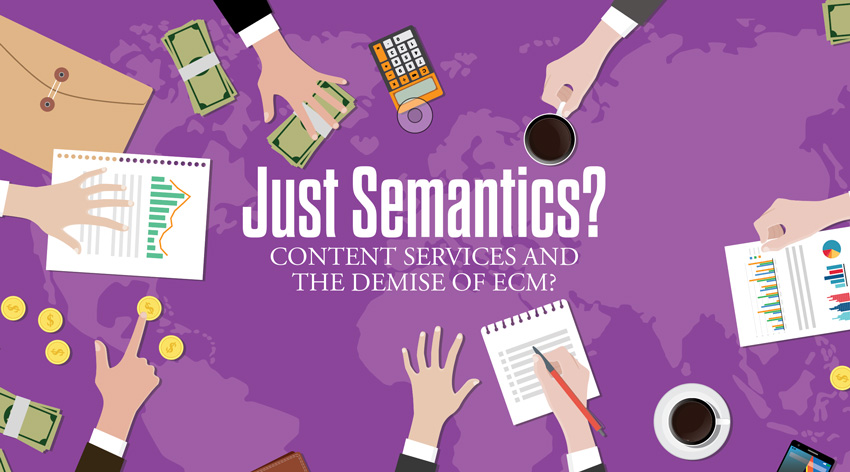Just Semantics? Content Services and the Demise of ECM?
Enterprise content management (ECM) software (sometimes referred to as content management systems, or CMS) emerged in the mid-nineties to manage disparate content types, from web content to internal e-documents, reports, and business records. So, when a document is rendered in various forms (e.g., web, electronic, print), only one file of the content is needed, and it is rendered consistently in the format needed. This one file is kept up-to-date for access across departments or the entire enterprise.
ECM can manage all types of content in the enterprise as objects, although in practice its focus is on managing unstructured content, while databases manage structured content. Structured content consists of data in rows and columns that can be manipulated arithmetically in calculations. This data is primarily financial and is often used in financial reports, business intelligence (BI), and analytics applications. Unstructured content is everything else—and by most estimates accounts for 80-90 percent of an organization’s total information—including those e-documents, e-records and e-mail. This may include scanned copies of documents like contracts or customer letters, loan or insurance applications, bills of lading, and land deeds, or internally created documents, like letters and memos, spreadsheets, audiovisual presentations, and other common business outputs.
ECM’s roots
Document imaging was the first of the ECM suite to develop, and started as a sort of electronic filing cabinet—a very expensive one. The technology did not really take off until the mid-1990s, when workflow capabilities were added to move folders and documents through worksteps in an automated way, capturing statistics along the way. Graphical workflow capabilities made designing the work process steps much easier. Some dedicated or “pure play” workflow companies emerged.
But imaging and workflow software did not yet manage other types of e-documents, only images, so soon a market for document management software opened up and those companies were soon swallowed by the big document imaging players like Wang, FileNet, and IBM. They also purchased report output and management software companies, at the time called computer output to laser disk (COLD) and later renamed ERM (enterprise report management). So document imaging evolved into document management and included report management. Then, the need for electronic records management (another ERM) capability became apparent. This was the marketplace’s response to organizations demanding complete information management solutions.
The major software firms in this marketplace developed complementary technology sets that became an integrated suite of ECM applications, which includes:
- Document imaging: scanning and digitizing paper documents.
- Document management: including versioning, renditioning, check-in/check-out of documents, and search capabilities.
- Records management: formally declaring documents as business records and track records according to retention and disposition schedules.
- Collaboration: working in team workspaces, creating, sharing, and editing documents with physically remote users.
- Web content management: maintaining one copy of content and publishing it in multiple places across the Web and on intranets.
- Digital asset management: managing graphic files such as logos, artwork, advertisements, marketing collateral, and other digital assets.
- Enterprise report management: creating, publishing,
and managing reports across the enterprise (which were formerly printed). - Workflow: automated routing through worksteps of the business process helped to speed approval and other decision processes, and workflow capabilities are often included in ECM suites or as add-ons.
ECM systems now provide powerful document management support for versioned e-documents, and ensure that users can easily retrieve the latest versions, while tracking revisions. But many users will still use out-of-date versions they have stored locally, outside the repository (e.g., from their desktop PC, tablet, or smartphone, or in their e-mail inbox). This can result in costly errors, wasted work, and, most important, failure to comply with current regulations and operating procedures. Going to a cloud-based approach can address these issues.
The ECM vs. Content Services Debate
A generation after its beginnings, in 2017, Gartner Group announced a renaming of ECM as “Content Services” (CS) that revolve around applications, platforms, and components (Woodbridge, 2017), and provided their rationale for doing so. That set off a virtual firestorm in the ECM marketplace, especially in the AIIM community.
The renaming and recasting of ECM was due, in part, because the promise of ECM was mostly never realized. David Jones, Director of Product Marketing at Nuxeo, noted earlier this year that:
“Traditional ECM vendors convinced enterprises to move to an approach focused around a single-repository with a suite of products built on top. What they actually delivered, however, was a monolithic architecture that was unable to grow and deliver against the customer expectation.”
In part because of dispersed and divergent electronic information repositories and cloud computing, businesses realized that what they really needed was access to information “intelligently and from anywhere.”
Enter CS. Rather than put ECM architecture front and center, businesses are discovering that with CS they put applications and processes ahead of the ECM structure. AIIM’s definition is:
CS is an alternative strategy to provide a more practical, multi-repository solution to achieve the benefits promised by the original vision of ECM:
to intelligently capture information, disseminate it
to the right people, processes, and departments,
while ensuring compliance and creating process and cost efficiencies.
What do you think? Is the change from ECM to CS real—and needed? Will it help organizations achieve better results than in the past?
recent posts
You may already have a formal Data Governance program in [...]

